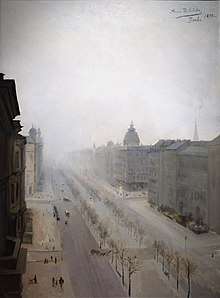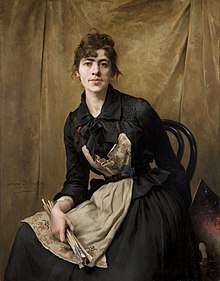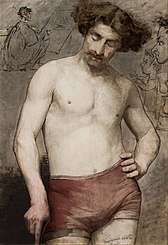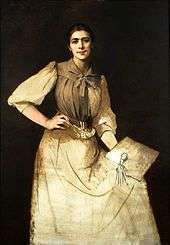Anna Bilińska-Bohdanowicz
Anna Bilińska-Bohdanowicz (8 December 1857, Zlatopol – 18 April 1893, Warsaw, Russian Empire) was a Polish painter, known for her portraits. She was born Anna Bilińska, the daughter of a Polish doctor in the formerly frontier town of Zlatopol in the Russian Empire (today part of Novomyrhorod), where she spent her childhood. About her origin Anna joked that she has a temper of Cossack, but a Polish heart (Polish: ma temperament kozaczy, ale serce polskie).[1] She lived with her father in Imperial Russia, where her first art teacher was Michał Elwiro Andriolli (Andriolli following the 1863–1864 January Uprising was exiled by the Tsarist government to katorga), before studying music and art in Warsaw where she became a student of Wojciech Gerson in 1877. During this time, she began to exhibit her work at the Zachęta Society for the Promotion of Fine Arts (Polish Towarzystwo Zachęty Sztuk Pięknych) in Warsaw.

Anna Bilińska-Bohdanowicz | |
|---|---|
 Self-Portrait with Apron and Brushes, 1887 | |
| Born | Anna Bilińska 8 December 1857 Zlatopol, Kherson Governorate, Russian Empire |
| Died | 18 April 1893 Warsaw, Russian Empire |
| Nationality | Polish |
| Education | Académie Julian |
| Known for | Painting |
| Spouse(s) | Antoni Bohdanowicz |
Life
In early 1882 she accompanied her chronically ill friend Klementyna Krassowska on a journey to Munich, Salzburg, Vienna and northern Italy, before travelling to and settling in Paris where she studied along with Marie Bashkirtseff at the Académie Julian,[2] and where later she also taught. She lived in France until 1892, where she married a medical doctor named Antoni Bohdanowicz and took his name (Anna Bilińska-Bohdanowiczowa). They returned to Warsaw after their marriage, where she intended to open a Parisian-style art school for women, but fell ill with a heart condition and died a year later on 18 April 1893.
Anna Bilińska-Bohdanowiczowa is best known for her portraits, painted with great intuition. Her Self-Portrait with Apron and Brushes (1887) developed a new self-portrait pose by placing the artist in front of a model's backdrop, thus stating that she is her own model.[3] She also painted still lifes, genre scenes and landscapes, and was a representative of realism. Her paintings can be found in the National Museum Warsaw and National Museum Kraków.
Legacy
Bilińska-Bohdanowicz was included in the 2018 exhibit Women in Paris 1850-1900.[4]

Selected paintings
 Muscle Man. Semi-nude male, 1885
Muscle Man. Semi-nude male, 1885 A Negress (Murzynka), 1884
A Negress (Murzynka), 1884 Self-Portrait, 1892
Self-Portrait, 1892
Bibliography
- Clara Erskine Clement, Women in the Fine Arts from the Seventh Century B.C. to The Twentieth Century A.D., 1904
- Magdalena Schlender, Die Selbstbildnisse der polnischen Malerin Anna Bilińska (The self-portraits of the Polish painter Anna Bilińska), Hamburg 2005
- Magdalena Schlender, Anna Bilińska Bohdanowicz, probably 2009.
References
- RENATA HIGERSBERGER. PIĘKNA, SKRADZIONA, ODZYSKANA. nimoz.pl
- culture.pl
- Frances Borzello, Seeing Ourselves: Women's Self-Portraiture, 1998.
- Madeline, Laurence (2017). Women artists in Paris, 1850-1900. Yale University Press. ISBN 978-0300223934.
External links
- Anna Bilińska-Bohdanowiczowa at culture.pl
![]()